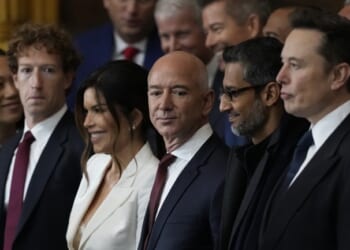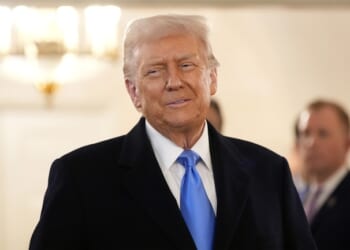We are publishing this important analysis of our epoch-changing times in three parts.
THE first weeks of the second Trump administration have been a wild ride. Like many, I’ve been blown away by the speed and scope of the blitzkrieg that Trump and his team have unleashed on the permanent managerial state in Washington. He has already fulfilled many of the priorities I outlined two months ago in The Counter-Revolution Begins, the most significant of which was to reject being conservative about institutions or the exercise of legitimate power. With its ‘you can just do things’ energy, Trump 2.0 seems to be the first administration serious about delivering on democratic demands for real change in American governance since FDR.
In fact, the blows continue to fall so fast that it’s hard to keep track of it all. But amid the furore kicked up by a dozen different world-shaking moves – from trying to annex Greenland through the closing of borders and imposition of trade tariffs to the dismantling of USAID – we can begin to glimpse a much bigger picture coming into view.
There’s a 2018 quote by the late Henry Kissinger that’s circulated recently, in which he mused about whether ‘Trump may be one of those figures in history who appears from time to time to mark the end of an era and to force it to give up its old pretenses’. If that wasn’t true in 2018 it certainly is now. I believe that what we’re seeing today truly is the end of an era, an epochal overturning of the world as we knew it, and that the full import and implications of this haven’t really struck us yet.
More specifically, I believe Donald Trump marks the overdue end of the Long Twentieth Century.
The 125-year period between the French Revolution in 1789 and the outbreak of WWI in 1914 was later described as the ‘Long Nineteenth Century’. The phrase recognised that to speak of ‘the nineteenth century’ was to describe far more than a specific hundred-year span, it was to capture the whole spirit of an age: a rapturous epoch of expansion, empire and Enlightenment, characterized by a triumphalist faith in human reason and progress. That lingering historical spirit, distinct from any before or after, was extinguished in the trenches of the Great War. After the cataclysm, and an interregnum that ended only with the conclusion of WWII, everything about how the people of Western civilization perceived and engaged with the world – politically, psychologically, artistically, spiritually – had changed.
R R Reno opens his 2019 book Return of the Strong Gods by quoting a young man who laments that ‘I am twenty-seven years old and hope to live to see the end of the twentieth century.’ His paradoxical statement captures how the twentieth century has also extended well past its official sell-by date in the year 2000. Our Long Twentieth Century had a late start, fully solidifying only in 1945, but in the 80 years since its spirit has dominated our civilization’s whole understanding of how the world is and should be. It has set all of our society’s fears, values, and moral orthodoxies. And, through the globe-spanning power of the United States, it has shaped the political and cultural order of the rest of the world as well.
The spirit of the Long Twentieth could not be more different from that which preceded it. In the wake of the horrors inflicted by WWII, the leadership classes of America and Europe understandably made ‘never again’ the core of their ideational universe. They collectively resolved that fascism, war and genocide must never again be allowed to threaten humanity. But this resolution, as reasonable and well-meaning as it seemed at the time, soon became an all-consuming obsession with negation.
Hugely influential liberal thinkers like Karl Popper and Theodor Adorno helped convince an ideologically amenable post-war establishment that the fundamental source of authoritarianism and conflict in the world was the ‘closed society’. Such a society is marked by what Reno dubs ‘strong gods’: strong beliefs and strong truth claims, strong moral codes, strong relational bonds, strong communal identities and connections to place and past – ultimately, all those ‘objects of men’s love and devotion, the sources of the passions and loyalties that unite societies’.
Now the unifying power of the strong gods came to be seen as dangerous, an infernal wellspring of fanaticism, oppression, hatred and violence. Meaningful bonds of faith, family, and above all the nation were now seen as suspect, as alarmingly retrograde temptations to fascism. Adorno, who set the direction of post-war American psychology and education policy for decades, classified natural loyalties to family and nation as the hallmarks of a latent ‘authoritarian personality’ that drove the common man to xenophobia and führer worship. Popper, in his sweepingly influential 1945 book The Open Society and Its Enemies, denounced the idea of national community entirely, labelling it as disastrous ‘anti-humanitarian propaganda’ and smearing anyone who dared cherish as special his own homeland and history as a dangerous ‘racialist’. For such intellectuals, any definitive claim to authority or hierarchy, whether between men, morals, or metaphysical truths, seemed to stand as a mortal threat to peace on earth.
The great project of post-war establishment liberalism became to tear down the walls of the closed society and banish its gods forever. To be erected on its salted ground was an idyllic but exceptionally vague vision of an ‘open society’ animated by peaceable weak gods of tolerance, doubt, dialogue, equality and consumer comfort. This politically and culturally dominant ‘open society consensus’ drew on theorists like Adorno and Popper to advance a program of social reforms intended to open minds, disenchant ideals, relativize truths and weaken bonds.
As Reno catalogues in detail, new approaches to education, psychology and management sought to relativize truths, elevate ‘critical thinking’ over character, vilify collective loyalties, cast doubt on hierarchies, break down all boundaries and borders, and free individuals from the ‘repression’ of all moral and relational duties. Aspiration to a vague universal humanitarianism soon became the only higher good that it was socially acceptable to aim for other than pure economic growth.
The anti-fascism of the twentieth century morphed into a great crusade – characterized, ironically, by a fiery zeal and fierce intolerance. By making ‘never again’ its ultimate priority, the ideology of the open society put a summum malum (greatest evil) at its core rather than any summum bonum (highest good). The singular figure of Hitler didn’t just lurk in the back of the 20th century mind; he dominated its subconscious, becoming a sort of secular Satan, forever threatening to tempt mankind into new wickedness. This ‘second career of Adolf Hitler’, as Renaud Camus jokingly calls it, provided the parareligious raison d’etre for the open society consensus and the whole post-war liberal order: to prevent the resurrection of the undead Führer.
This doctrine of prevention grants enormous moral weight to ensuring that open society values triumph over those of the closed society in every circumstance. If it’s assumed that the only options are ‘the open society or Auschwitz’, then maintaining zero tolerance for the perceived values of the closed society is functionally a moral commandment. To stand in the way of any possible aspect of societal opening and individual liberation – from secularization, to the sexual revolution and LGBTQ rights, to the free movement of migrants – was to do Hitler’s work and risk facilitating fascism’s return (no matter how far removed the subject concerned from actual fascism). It was established as the open society’s only inviolable rule that, as Reno puts it, it is ‘forbidden to forbid’. Thus a strict new cultural orthodoxy was consolidated, in which to utter any opinion contrary to the continuous project of further opening up societies became verboten as a moral evil. Complete inclusion required rigorous exclusion. We are familiar with this dogma today as political correctness.
The end of the Cold War sent the open society consensus into overdrive. Far from moderating its zeal, the fall of Soviet communism (liberalism’s last real ideological competitor) seemed to validate the moral and practical superiority of the open society, and the post-Cold War establishment doubled down on the belief that the whole world could and should be rebuilt in its image, ushering in the end of history.
To be continued tomorrow.
This article appeared on The Upheaval on February 13, 2025, and is republished by kind permission.








